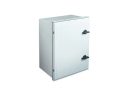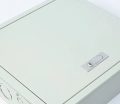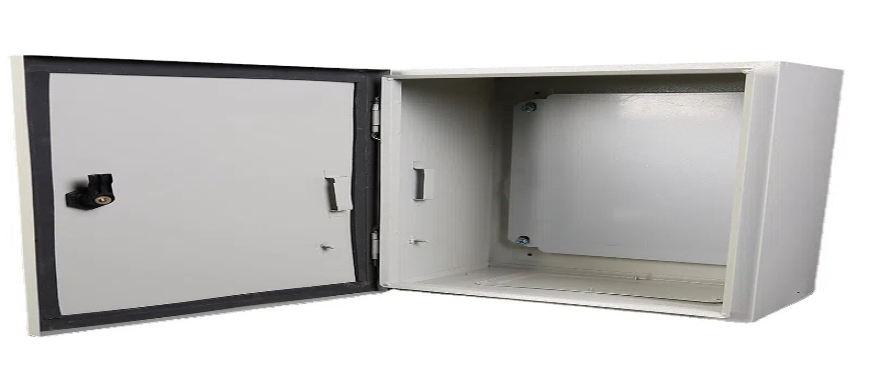
Fiberglass boxes with lids are essential storage solutions used in many industries. Fiberglass Box with Lid blend aesthetics and function is designed to provide optimum protection in the harshest of environments. They provide excellent protection against harsh environmental conditions, such as moisture and corrosion. These boxes are ideal for safely housing sensitive equipment and valuable materials. Their lightweight yet durable design makes them easy to handle and install. Additionally, fiberglass boxes with lids are available in various sizes and configurations, catering to diverse needs. Many businesses rely on these boxes to ensure the safety and longevity of their contents. By choosing a fiberglass box with lid, users can enhance organization while maintaining a high level of protection in challenging settings.
Fiberglass Box with Lid Standard
The process of making a fiberglass box with a lid involves precise steps and adherence to industry standards to ensure quality, durability, and functionality. Below is a detailed description of the standard practices:
Material Selection
- Fiberglass Material: Choose high-quality fiberglass reinforced plastic (FRP) with sufficient strength and durability.
- Resin: Use appropriate resin such as polyester, vinyl ester, or epoxy, depending on environmental exposure (e.g., UV, moisture, or chemicals).
- Additives: Include necessary additives for fire retardancy, UV resistance, or color pigmentation if required.
- Reinforcement: Select glass fiber mats or woven roving for structural integrity.
Design Specifications
- Dimensions: Ensure the box and lid dimensions meet the application requirements.
- Wall Thickness: Maintain a uniform wall thickness, typically between 3-10 mm, depending on load and usage.
- Edge Reinforcements: Incorporate reinforced edges to prevent cracking or warping.
- Hinges/Locks: Plan for integrated hinges, locks, or seals for ease of operation and secure closure.
Mold Preparation
- Mold Material: Use a high-quality mold made from steel, aluminum, or FRP for precision.
- Surface Finish: Polish the mold surface for a smooth finish and apply a release agent (e.g., wax or PVA) to prevent sticking.
- Customization: Ensure mold design accommodates features like ribs, grooves, or inserts.
Fabrication Process
Hand Lay-Up Method (Common for Small to Medium Batches):
- Gel Coat Application: Apply a uniform gel coat layer on the mold for a smooth finish and protection.
- Reinforcement Placement: Place fiberglass mats or woven roving onto the mold.
- Resin Application: Saturate the reinforcement with resin using a brush or roller, ensuring no air bubbles.
- Layering: Add multiple layers of reinforcement and resin for required thickness and strength.
- Curing: Allow the resin to cure at room temperature or use an oven for accelerated curing.
Resin Transfer Molding (RTM) (For High Precision):
- Closed Mold Setup: Position reinforcement in a closed mold.
- Resin Injection: Inject resin under pressure for even distribution.
- Curing: Maintain controlled temperature and pressure for uniform curing.
Packaging and Storage
- Protection: Wrap the box and lid in protective material to avoid scratches.
- Labeling: Include labels with product details, handling instructions, and specifications.
- Storage: Store in a clean, dry environment away from direct sunlight and high humidity.
Environmental and Safety Compliance
- Emissions: Use eco-friendly materials and methods to minimize emissions during production.
- Waste Management: Dispose of resin and fiberglass scraps responsibly.
- Safety: Equip workers with personal protective equipment (PPE) such as gloves, masks, and goggles.
By adhering to these standards, fiberglass boxes with lids can be manufactured to deliver excellent performance, durability, and safety across a range of applications.
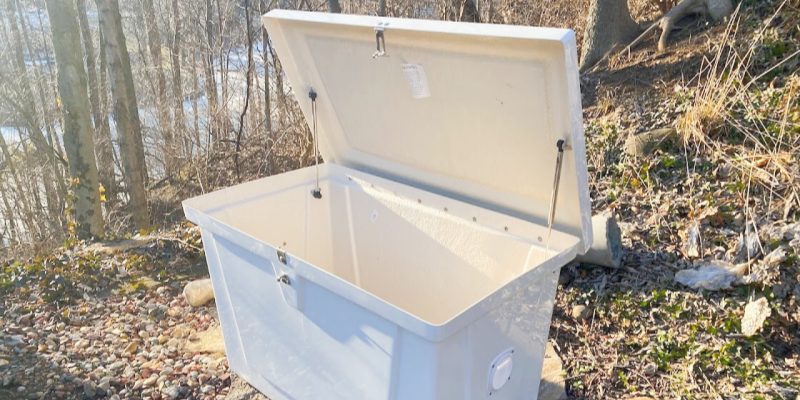
NEMA Rating of Fiberglass Box with Lid
A NEMA (National Electrical Manufacturers Association) rating is a standard used in the United States to classify enclosures based on their ability to protect electrical components against environmental conditions. When applied to a fiberglass box with a lid, the NEMA rating indicates the level of protection the box offers against factors like dust, water, corrosion, and impact. Here is a detailed breakdown:
Common NEMA Ratings for Fiberglass Boxes with Lids
- NEMA 1:
- Protection: Provides a basic level of protection against solid objects like dust and accidental contact with internal components.
- Use Case: Indoor environments where there is minimal exposure to moisture or hazardous conditions.
- NEMA 3R:
- Protection: Shields internal components from falling rain, snow, and sleet but does not provide full water-tight sealing.
- Use Case: Outdoor settings, such as electrical panel boxes mounted on building exteriors.
- NEMA 4:
- Protection: Offers protection against windblown dust, rain, and hose-directed water, making it water-tight.
- Use Case: Industrial and outdoor environments where the box might be exposed to heavy rain or hose cleaning.
- NEMA 4X:
- Protection: Similar to NEMA 4, but with added resistance to corrosion.
- Use Case: Marine environments, food processing facilities, and areas with high levels of corrosive agents.
- NEMA 6:
- Protection: Protects against temporary submersion in water.
- Use Case: Applications where the enclosure might be briefly submerged, such as in flood-prone areas.
- NEMA 12:
- Protection: Guards against dust, dirt, and dripping water.
- Use Case: Indoor industrial settings where machinery and dust are common.
- NEMA 13:
- Protection: Adds resistance to oil and coolant seepage, in addition to dust and water.
- Use Case: Manufacturing facilities using cutting fluids or lubricants.
When selecting a fiberglass box with a lid, the appropriate NEMA rating depends on the specific environmental conditions and application. Fiberglass enclosures are versatile and durable, making them an excellent choice for both indoor and outdoor use across various industries. Always verify the rating to ensure compatibility with the intended operating environment.
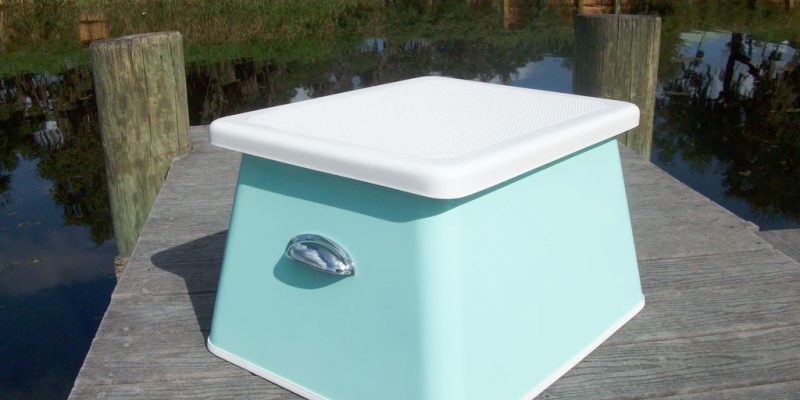
Size of Fiberglass Box with Lid
A fiberglass box with a lid is a container designed to provide durability, strength, and resistance to environmental factors. Here’s a detailed description of its potential size and features:
Dimensions
- Length: Typically ranges from small (12 inches or 30 cm) to large (72 inches or 180 cm), depending on usage.
- Width: Varies from narrow (8 inches or 20 cm) to wide (36 inches or 90 cm).
- Height: Can be shallow (6 inches or 15 cm) or deep (48 inches or 120 cm).
Material Thickness
- Walls and Lid: Fiberglass thickness often ranges between 3 mm to 10 mm, ensuring sturdiness without adding excessive weight.
- Reinforcements: May include thicker sections at edges or corners for enhanced durability.
Lid Design
- Flat or Domed: Some lids are flat for stacking; others are domed to prevent water pooling.
- Hinged or Detachable: Hinged lids allow for easy opening, while detachable lids offer complete access.
- Sealing: Many fiberglass boxes have rubber or silicone gaskets for a watertight or airtight seal.
Capacity
- Measured in liters or cubic inches:
- Small boxes: 5 to 20 liters (300 to 1,200 cubic inches).
- Medium boxes: 20 to 100 liters (1,200 to 6,000 cubic inches).
- Large boxes: 100 liters and above (6,000+ cubic inches).
Weight
- Depends on size and material thickness but generally ranges from 2 kg (4.4 lbs) for small boxes to 50 kg (110 lbs) or more for large ones.
Service Temperature Range of Fiberglass Box with Lid
A fiberglass box with a lid is a durable and versatile enclosure typically used in industrial, commercial, or outdoor settings to protect electrical or mechanical components. Understanding its service temperature range is crucial for ensuring reliable performance and longevity under varying environmental conditions. Below is a detailed description of its service temperature characteristics:
General Temperature Range
Fiberglass boxes are designed to withstand a wide range of temperatures due to the inherent properties of the fiberglass-reinforced plastic (FRP) material. Typically, the service temperature range is:
- Low-end temperature: -40°C to -50°C (-40°F to -58°F)
- High-end temperature: +120°C to +150°C (+248°F to +302°F)
This makes the box suitable for both extremely cold and hot environments.
Factors Influencing Temperature Performance
The actual temperature range can vary based on several factors:
- Resin Type:
- Fiberglass boxes are often made with polyester, vinyl ester, or epoxy resins, each offering different thermal resistances.
- Epoxy resins typically provide the highest heat resistance, while polyester is more cost-effective but with a slightly lower temperature threshold.
- Wall Thickness:
- Thicker walls improve insulation and resistance to temperature extremes, extending the usable range.
- Coatings and Finishes:
- UV-resistant or thermal-resistant coatings can enhance the box’s ability to withstand prolonged exposure to heat or cold.
- Sealing Mechanisms:
- High-quality gaskets and seals ensure that the internal components are insulated from ambient temperature fluctuations.
Performance in Extreme Conditions
- Cold Environments:
- The low-end temperature limit ensures that the fiberglass material remains structurally stable without becoming brittle or cracking under freezing conditions.
- Applications in refrigerated storage or polar climates are common.
- Hot Environments:
- The high-end temperature limit allows the box to function in direct sunlight, near industrial machinery, or in desert conditions without warping or losing mechanical integrity.
Maintenance and Testing
- Regular inspection of seals and gaskets is recommended to ensure performance within the service temperature range.
- In high-temperature settings, verify that internal components are not exposed to heat beyond their rated limits.
By understanding the service temperature range and associated factors, users can confidently deploy fiberglass boxes with lids in environments that demand both resilience and reliability.
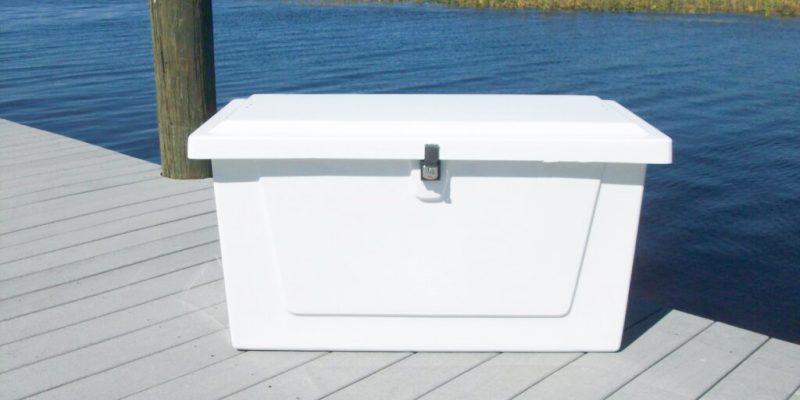
Benefits of Using a Fiberglass Box with Lid
Fiberglass boxes with lids offer numerous advantages across various applications. Their design and materials contribute significantly to their popularity. Here are some key benefits:
Durability and Protection Against Environmental Factors
Resistance to Corrosion: Fiberglass does not rust, making it ideal for wet environments.
Impact Resistance: These boxes can withstand physical impacts, protecting contents from damage.
Weather Resistance: Fiberglass boxes with lids endure extreme weather conditions, including rain and UV exposure.
Chemical Resistance: They resist various chemicals, making them suitable for industrial applications.
Long Lifespan: The durability of fiberglass means these boxes last longer than many alternatives.
The durability of a fiberglass box with lid ensures that equipment remains safe over time. Many industries, such as oil and gas, utilize these boxes due to their resistance to harsh chemicals. Studies show that fiberglass materials, like those used in an industrial fiberglass box, can last decades without significant degradation.
Versatility in Storage Solutions for Different Industries
Wide Range of Applications: Fiberglass boxes with lids serve various sectors, including construction, agriculture, and pharmaceuticals.
Customizable Sizes: These boxes come in different dimensions, accommodating specific storage needs.
Multiple Configurations: Users can choose from different lid types, including hinged and removable options.
Portability: Lightweight designs allow for easy transport and relocation.
Easy Maintenance: Cleaning fiberglass boxes is straightforward, ensuring hygiene in sensitive environments.
In construction, for instance, a fiberglass box with lid may be used to store tools and equipment securely. The versatility of these boxes allows businesses to tailor solutions to their unique challenges. Research indicates that customized storage options can improve operational efficiency.
Additional Considerations
While fiberglass boxes with lids have many advantages, it’s essential to consider their limitations as well.
Cost: Fiberglass boxes may be more expensive than some plastic alternatives.
Weight: Although lightweight, they can still be heavier than some other materials.
Brittleness: In extreme conditions, fiberglass may become brittle over time.
Despite these drawbacks, many companies find that the benefits outweigh the negatives. A fiberglass box with lid provides unmatched protection and longevity, making it a worthwhile investment.
Real-World Examples
Several industries have adopted fiberglass boxes with lids for their robust properties.
Water Treatment Facilities: These boxes protect sensitive electrical equipment from moisture.
Chemical Processing Plants: Fiberglass boxes with lids safeguard materials from spills and chemical exposure.
Agriculture: Farmers use them for storing seeds and fertilizers, preventing contamination.
In each case, the use of fiberglass boxes with lids enhances safety and efficiency. Businesses report reduced maintenance costs due to the durability of these boxes, much like the reliability of ultralight fiberglass rods in various applications.
The benefits of using a fiberglass box with lid are clear. Their durability and versatility make them suitable for various applications. By investing in fiberglass boxes with lids, companies can ensure protection and efficiency in their operations.
Why an Old Work Fiberglass Box is Ideal for Renovations
Types of Fiberglass Boxes with Lids
Fiberglass boxes with lids come in various types, each designed for specific applications. Understanding the differences can help you select the right box for your needs. Here, we explore two common fiberglass types of box: the large fiberglass box with lid and the fiberglass box with hinged lid.
Large Fiberglass Box with Lid
Large fiberglass boxes with lids are essential in numerous industries. They provide ample storage space while ensuring maximum protection.
Features:
Spacious Interior: Designed to accommodate larger equipment or multiple items.
Heavy-Duty Construction: Made with thick fiberglass to withstand harsh conditions.
Weather Resistance: Built to resist rain, snow, and extreme temperatures.
Secure Latching Mechanism: Keeps contents safe from unauthorized access and environmental factors.
Custom Sizes Available: Tailored dimensions can fit specific equipment or applications.
Applications:
Industrial Settings: Used to store tools and machinery in factories or warehouses.
Marine Use: Protects equipment on boats or in coastal areas, where moisture is a concern.
Utility Companies: Houses electrical components or control panels outdoors.
Construction Sites: Provides secure storage for tools and safety equipment.
Fiberglass Box with Hinged Lid
Fiberglass boxes with hinged lids offer unique advantages for various applications. Their design facilitates easy access while maintaining protection.
Advantages:
Easy Accessibility: The hinged lid allows for quick opening and closing, streamlining access.
Space Efficiency: The lid can stay open without requiring additional space, ideal for tight areas.
User-Friendly Design: Simplifies the process of retrieving and storing items.
Versatile Applications: Suitable for both indoor and outdoor use, adapting to various needs.
Enhanced Safety Features: Often equipped with locking mechanisms to prevent unauthorized access.
Specific Use Cases:
Electrical Enclosures: Houses sensitive electrical components that need regular maintenance.
Outdoor Storage: Ideal for storing gardening tools or equipment that require frequent access.
Workshops: Provides convenient access to tools and materials for crafts or repairs.
Telecommunications: Protects sensitive electronics while allowing for easy service access.
The types of fiberglass boxes with lids available is crucial for selecting the right solution. Both the large fiberglass box with lid and the fiberglass box with hinged lid offer unique features and benefits suited for different environments and applications.
Where to Find Fiberglass Box with Lid Nearby
When searching for a fiberglass box with lid, finding local suppliers is crucial. At GangLong Fiberglass, we prioritize quality and accessibility for our customers. Here are some tips to help you locate reliable suppliers and retailers nearby.
Tips for Locating Local Suppliers and Retailers
Online Directories: Use online directories to find local suppliers of fiberglass boxes with lids. Search for keywords like “fiberglass box with lid” and “local suppliers.”
Industry Trade Shows: Attend trade shows focused on industrial equipment. These events showcase various manufacturers and their products.
Networking: Connect with industry professionals. They can often recommend trusted suppliers based on their experiences.
Local Hardware Stores: Visit hardware and construction supply stores. Many carry fiberglass boxes with lids suitable for various applications.
Referrals: Ask colleagues or business partners for referrals. Word-of-mouth recommendations can lead to reputable suppliers.
Importance of Checking for Product Ratings and Specifications
Quality Assurance: Always check product ratings before purchasing a fiberglass box with lid. High ratings often indicate reliable performance.
Material Specifications: Review the specifications of fiberglass boxes with lids. Ensure they meet your requirements for durability and protection.
NEMA Ratings: Look for NEMA ratings to determine the enclosure’s environmental protection level. This information is critical for outdoor applications.
Customer Reviews: Read customer reviews to gain insights into the product’s effectiveness and any potential issues.
Return Policies: Understand the return policies of suppliers. This knowledge protects you if the product does not meet your expectations.
By following these tips, you can successfully locate a fiberglass box with lid that meets your needs. At GangLong Fiberglass, we aim to provide high-quality solutions for various industries. We emphasize the importance of careful selection when purchasing fiberglass boxes with lids.
Exploring Fiberglass Enclosure Box Options
Fiberglass enclosure boxes provide excellent protection for various applications. These sturdy boxes are essential for housing sensitive equipment. A fiberglass box with lid ensures items remain safe from environmental hazards. Many industries utilize these boxes, making them versatile storage solutions.
Overview of Fiberglass Enclosure Boxes and Their Uses
Protection from Elements: These boxes shield contents from moisture, dust, and extreme temperatures.
Electrical Applications: Fiberglass enclosure boxes are commonly used to protect electrical components.
Industrial Settings: They are suitable for harsh environments, such as oil refineries and chemical plants.
Outdoor Use: The weather-resistant nature allows for safe outdoor installation.
Customization: Many manufacturers offer tailored options to meet specific industry needs.
Comparison of Types Available
| Size | Type | Common Uses |
|---|---|---|
| 10x10x5 | Wall Mount Enclosure | Small electrical components |
| 10x3x3 | Fiberglass Box with Lid | Outdoor electrical connections |
| 12x12x6 | Free Standing Enclosure | Equipment storage |
| 14x14x8 | Heavy Duty Enclosure | Industrial machinery protection |
| 16x16x10 | Large Fiberglass Enclosure | Control panels in factories |
Fiberglass boxes with lids come in various sizes, making them adaptable for different needs. The selection of sizes and types enhances their functionality across industries.
Portable Fiberglass Box Stand for Easy Hunting Setup
Fiberglass Box with Lid for Sale
When searching for a fiberglass box with lid for sale, several factors come into play. Understanding these factors can help ensure a suitable purchase.
Factors to Consider When Purchasing
Material Quality: Ensure the fiberglass box with lid is made from high-quality materials. This factor impacts durability and longevity.
NEMA Rating: Check the NEMA rating for environmental protection. This rating determines how well the box resists water, dust, and chemicals.
Size Requirements: Consider the size of the box needed. Ensure it fits the intended application.
Installation Ease: Look for features that facilitate easy installation, such as mounting options.
Door Type: Decide between different door styles, such as hinged or lift-off doors, based on convenience.
Current Market Trends and Pricing Information
Growing Demand: The demand for fiberglass boxes with lids is increasing in various industries.
Competitive Pricing: Prices vary based on size, material, and manufacturer. Generally, larger boxes are priced higher.
Customization Options: Custom features may come at an additional cost, but they offer tailored solutions.
Online Shopping: Many buyers prefer online purchasing, leading to more competitive pricing.
Sustainability Focus: There is a rising trend towards environmentally friendly materials and manufacturing processes.
By understanding these factors and market trends, you can make informed decisions when seeking a fiberglass box with lid for sale. Investing in quality products ensures durability and effectiveness in protecting your valuable equipment.
Leading Fiberglass Fiberglass Box With Lid Manufacturers
The fiberglass enclosure market has several key manufacturers that set industry standards. These companies specialize in producing high-quality fiberglass boxes with lids. Their commitment to innovation and quality ensures reliable products for various applications.
Discussion of Key Manufacturers in the Industry
Market Leaders: Several manufacturers are recognized as leaders in fiberglass enclosure production. They are known for their extensive product ranges.
Reputation for Quality: Many companies focus on creating durable and long-lasting fiberglass boxes with lids. This reputation helps build customer trust.
Research and Development: Leading manufacturers invest in research to develop advanced materials and technologies. This focus drives innovation in product design.
Customer Service: Strong customer support from manufacturers enhances user experience. Customers often rely on manufacturers for installation advice and product specifications.
Innovations and Quality Standards in Fiberglass Enclosures
Advanced Materials: Innovations include the use of high-performance resins that improve durability and resistance.
Improved Designs: Many manufacturers focus on ergonomic designs for ease of use and installation.
Environmental Standards: Compliance with environmental regulations ensures that products are safe and sustainable.
Quality Certifications: Certifications such as ISO 9001 indicate adherence to high-quality manufacturing processes.
Enhanced Customization: Innovations allow for more customizable options, catering to specific industry needs.
By understanding the role of leading manufacturers, customers can make informed choices when purchasing a fiberglass box with lid. Their commitment to quality and innovation significantly benefits the market.
Large Fiberglass Box With Lid
Large fiberglass electrical enclosures serve specialized applications in various electrical setups. These enclosures protect sensitive components from environmental hazards.
Specialized Applications in Electrical Setups
Control Panels: Large fiberglass boxes with lids are often used for housing control panels in industrial settings.
Electrical Distribution: They protect electrical distribution systems from moisture and debris, ensuring efficient operation.
Generator Housing: Many generators are housed in large fiberglass enclosures to protect them from the elements.
Telecommunications: These boxes are ideal for telecommunications equipment, safeguarding sensitive electronics from interference.
Features That Distinguish Electrical Enclosures from General Boxes
Higher NEMA Ratings: Electrical enclosures often have higher NEMA ratings, ensuring better protection against environmental factors.
Ventilation Options: Many fiberglass electrical enclosures include ventilation features to manage heat dissipation, similar to the functionality of a ventilated cable tray, ensuring proper airflow and cooling.
Cable Management Systems: Specialized designs allow for effective cable management, reducing clutter and improving organization.
Internal Mounting Options: These enclosures often provide various mounting options for easy installation of electrical components.
Sealing Mechanisms: Enhanced sealing mechanisms ensure that the contents remain protected from water and dust ingress.
Large fiberglass box with lid are essential for safeguarding electrical setups. Their specialized features differentiate them from general fiberglass boxes with lids, making them suitable for critical applications. Understanding these differences helps in selecting the right enclosure for specific needs.
Fiberglass Diesel Engine Box for Marine and Industrial Use
Final Thoughts on Fiberglass Box with Lids
Fiberglass boxes with lids are vital storage solutions across various industries. Their unique features provide essential protection and versatility. Understanding the importance of these enclosures can guide effective purchasing decisions.
Recap of the Importance of Fiberglass Boxes with Lids
Durability: Fiberglass boxes with lids are highly durable, ensuring long-lasting use in challenging environments.
Environmental Protection: These boxes offer excellent protection against moisture, dust, and extreme temperatures.
Versatility: They can be used in numerous applications, including electrical setups, outdoor storage, and industrial settings.
Safety: The secure design of a fiberglass box with lid helps protect valuable equipment from damage.
Cost-Effectiveness: Investing in quality fiberglass boxes with lids can reduce long-term maintenance costs.
Encouragement to Explore Various Options for Specific Needs
Assess Requirements: Evaluate your specific storage needs before selecting a fiberglass box with lid.
Consider Customization: Explore customization options to better meet your industry requirements.
Research Suppliers: Investigate various suppliers to find reliable fiberglass boxes with lids that suit your budget.
Stay Informed: Keep up with market trends to discover new products and innovations in fiberglass enclosure technology.
Seek Expert Advice: Don’t hesitate to consult experts or industry professionals for recommendations.
By recognizing the benefits of fiberglass boxes with lids, you can make informed choices for your storage solutions. Explore the available options to find the perfect fit for your specific needs.

As the editor of GangLong Fiberglass, I have years of experience and in-depth research, focusing on cable tray products, fiberglass solutions, and grille systems. I incorporate years of industry insights and practical experience into every content, committed to promoting the progress of the industry. At GangLong Fiberglass, my commitment is reflected in every product, from innovative cable trays to durable fiberglass solutions and sturdy grille systems. As an authoritative voice in the industry, my goal is to provide valuable information to professionals and businesses and promote forward-looking solutions.

